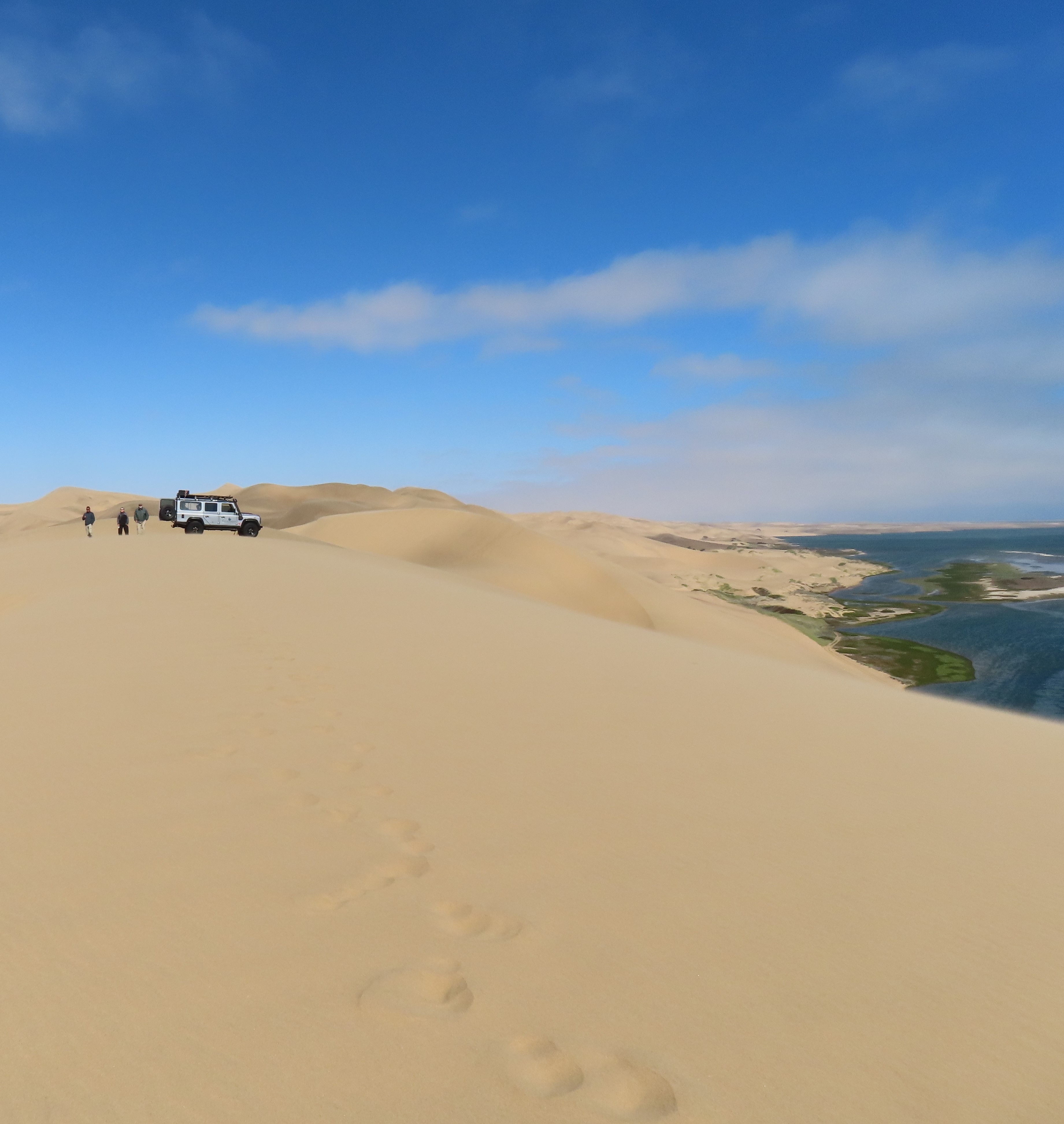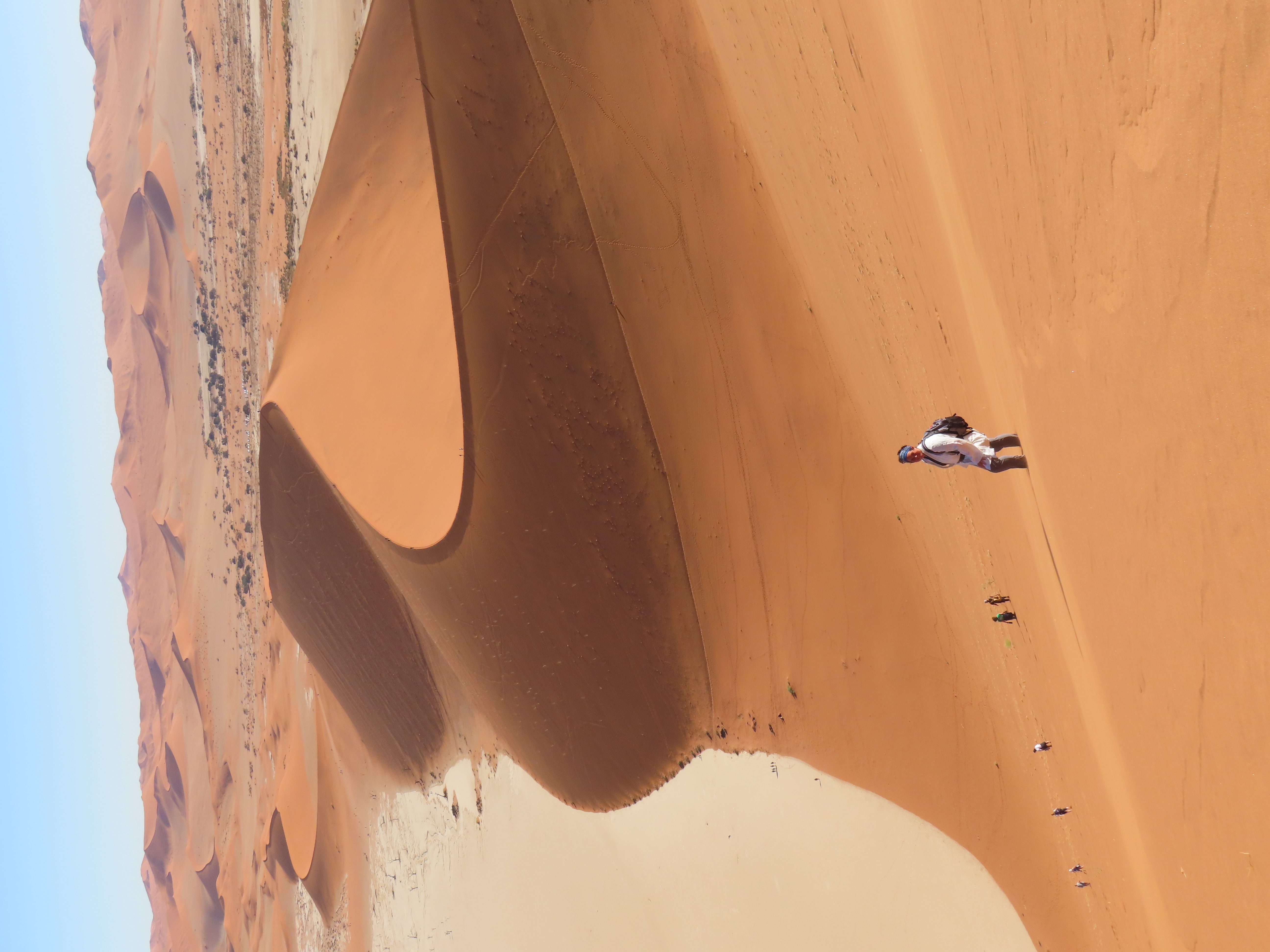
Curator’s statement
My fifth trip to Africa seemed like the right time to go off the beaten path into Namibia, known for its unspoiled wilderness. Namibia is home to the Namib, the oldest desert in the world with some of the highest sand dunes, and features intriguing desert wildlife. Here's what we discovered.
The Fora Difference
Book with Mei-Mei to access exclusive perks and experiences on your trip.
Killer perks
Free upgrades, spa credits and more—we got you
Personalized recs
Customized travel planning for your style
Insider knowledge
Expert advice from people who’ve actually been there
Where to stay
Unlock perks by contacting Mei-Mei to book your trip.
Day 1: Arrive in Windhoek, Namibia

Breakfast with Sophie and Gustaf (the giraffes) at Voigtland Guesthouse
Fly into Windhoek, Namibia's capital. Get your rental car and head to nearby Voigtland Guest House to relax in the farm landscape and rustic rooms — and meet Sophie.
She's one of three resident giraffes you can feed at tea or breakfast (the largest giraffe is more aloof). Her tongue is about 10 feet long (ok, slight exaggeration), as dexterous as a snake and a little slurpy as she reaches for the acacia pods you hold out. This is a fabulous giraffe close encounter for a song.
Days 2-3: Endangered wildlife

We met Artemis on our pangolin walk
Drive to Okonjima, a cattle and hunting farm converted to a private nature reserve. It is focused on wildlife research and conservation through its non-profit, AfriCat, but feels a little like a theme park for rhinos and cheetahs.
Among the special highlights offered are tracking rhinos, collared cheetahs and the main attraction: tagged pangolins! These rare, elusive, passive, nocturnal mammals are shaped like an anteater but covered in plate-like scales, made of keratin, like human nails. Pangolins are the world’s most trafficked mammals, prized for their scales and meat. Going on a "pangolin walk" and spotting one foraging and slithering is a unique treat.
If you're traveling as a group, stay at the gorgeous four-bedroom Villa with its own chef, pool and waterhole.
Days 4-5: Etosha watering holes

Rhinos gather at Ongava's watering hole at night
Head north to Etosha National Park, Namibia's primary wildlife where watering holes draw elephants, giraffes, zebra, wildebeest, antelope and more. The park, where you can self-drive, features a 100-million-year-old salt pan that's so vast, it can be seen from space.
Stay at Ongava Lodge for its small watering hole, which drew elephants, rhinos and lions during our stay. You might have to skip dessert to trot down to the hide for a closeup of the watering hole. We saw more rhinos here than on any of our other Africa safaris.
Days 6-7: Wildlife and sand dunes

Sandwich Harbour is on the right, below the dunes
We have a long drive to reach Walvis Bay, at the junction of desert and ocean. (Stop at Ongwari Café on the way from Ongava!)
From here, boat or kayak to eco-sensitive Pelican Point to revel in the active dolphins, birds and 50,000-plus Cape fur seals (and whales in season). Take a braai lunch break with champagne and local oysters while listening to the seals bark.
Then transfer to a 4x4 to race the Atlantic waves along the desert sand on a route that's only occasionally passable. Climb up steep silky dunes for views of beautiful Sandwich Harbour below, surrounded by golden sand and blue sea. This is part of the huge Namib desert, perhaps the oldest in the world. You'll soon see it from different points of view.
Around Walvis Bay, check out the flamingos, salt pans and “Dune 7,” with great views and sand boarding.
Days 8-11: Into the Sossusvlei Desert

Coming down Big Daddy at Sossusvlei
Today we're headed to the amazing Sossusvlei Desert Lodge, our home for the next four nights. (Stop at Solitaire, a great oasis famed for its apple crumble pie.)
Just staying here is heavenly — serene and surreal. The 12 suites seem rugged and other-worldly from the outside. However, they are pure decadence inside, including a retractable shade above the bed to admire the stars, a full bar, private plunge deck and plunge pool.
But we have a desert to explore! The Namib-Naukluft National Park is likely the oldest desert in the world, at 55 million-80 million-plus years old.
The lodge offers a 45-minute helicopter ride over the park, with fascinating views of the different hues and shapes of the dunes (you can upgrade to longer flights).
It'll take about 45 minutes to drive into the park, leaving early so you can catch the sunrise over the golden dunes. My daughter and I climbed Big Daddy, the highest dune there and among the highest in the world. It’s only 1,066 feet but all silky sand: tough going up but great fun going down. We went slowly and it took us two hours.
At the bottom, you'll hike through the salt flat called Deadvlei, filled with frozen tree fossils.
Also offered are dune outings and hikes around the property. And, nearly nightly, their astronomers will guide you through a star feast with a sophisticated telescope.
Day 12: Homeward

Desert paradise at the Sossusvlei Desert Lodge
After a lazy breakfast in your desert paradise, head back to Windhoek to fly home. You'll treasure your memories and the sand you're likely tracking home.
Need to know
Many Namibian roads are rough and unpaved, leading to flat tires. Be prepared!
If time permits, check out the famed Skeleton Coast with its shipwrecks, the historic rock art and Spitzkoppe Mountains in Damaraland, or Fish River Canyon.

Travel Advisor
Mei-Mei Kirk

Get in touch with Mei-Mei
Did you like this guide? Reach out to customize and book your own experience. Or, just to chat about travel in general.
You can expect a response from Mei-Mei within 1–2 business days. You’ll also be subscribed to our traveler newsletter (you can unsubscribe at any time).
For more inspiration and insider recommendations, visit our Namibia page.